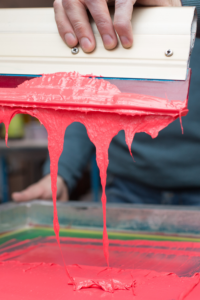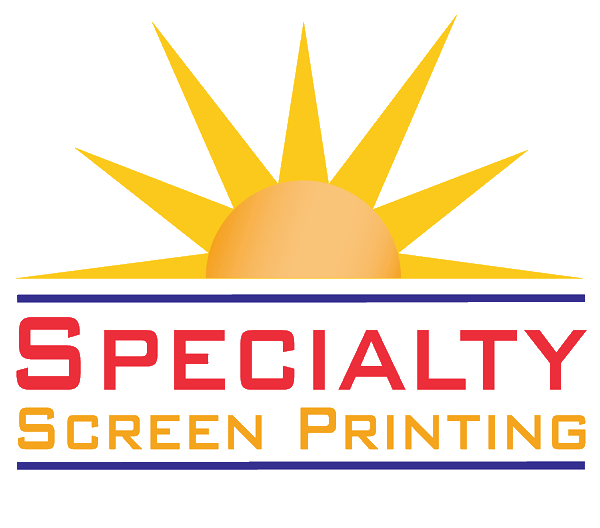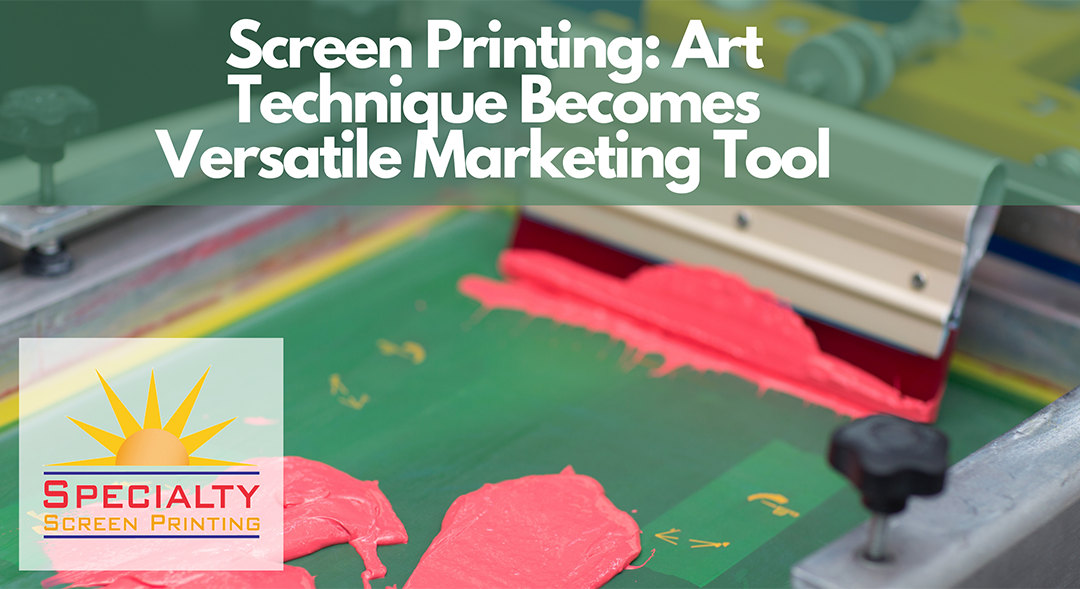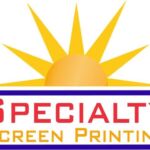If you’ve driven past a political campaign sign, noticed a bumper sticker or wandered by a store with a professional-looking sign in the window, you’ve seen the results of screen printing.
When it comes to screen printing, also called silk screen printing, signs are only part of the story. Plastic or metal covers and housings for gadgets around your house might have screen-printed branding or logos on them.
Thanks to Covid-19, you might have stepped on a screen-printed “6 feet apart” floor graphic at a local store.
Screen Printing Ingredients
But what is screen printing, and why has it become such a popular process for labeling our surroundings and promoting our products?
The essential ingredients of screen printing are:
- A stencil (with holes cut out for shapes and letters);
- A mesh screen (once made with hair, then silk, and now polyester);
- A frame to hold the screen and stencil in place;
- Ink;
- Material on which to print. In printer’s lingo they call that “substrate;”
- A squeegee.
The Screen Printing Process
 The process is similar to what you might remember from printing class in school. Place the framed stencil and silk over the material to be imprinted. Put some ink on the frame, and use the squeegee to spread the ink across the screen.
The process is similar to what you might remember from printing class in school. Place the framed stencil and silk over the material to be imprinted. Put some ink on the frame, and use the squeegee to spread the ink across the screen.
The ink is pushed through the holes in the screen onto the substrate, and voila! You’ve got a sign, poster, etc., ready for drying. And once the screen and stencil are set up, just add ink to repeat the process for 50, 100 or 1,000 pieces.
If the work requires more than one color, the printer makes additional stencils and frames and makes sure everything lines up. More colors are added one frame at a time.
The History of Screen Printing
According to some art historians, ancient stenciled artwork is a predecessor to screen printing. There is still some debate about whether silk-screening originated in China or Japan. Screen printing was a way to decorate fabric with repeatable shapes.
Silk-screening didn’t arrive in Europe until the 1700s when it became easier to import silk from the Far East.
Not surprisingly, commercial screen printing for signs, flags and banners originated in the United States in the early 20th century. Commercial artists saw the advantages to screen printing, and the industry grew.
An Updated Stenciling Process
In modern screen printing, stencils are applied directly to the screen. First, a photo-sensitive emulsion is applied to the entire screen. After it dries, the pattern or film, is laid over the screen. The entire frame is exposed to ultraviolet light.
The section of emulsion that was exposed to light hardens and the unexposed areas are washed away with water. The ink only flows through the screen where the emulsion has been removed.
Why Use Screen Printing?
You can screen print on almost any surface – fabric, vinyl, plastic, metal, wood, glass, cardboard, etc. Your local screen printer can also accommodate print runs from just a few pieces to thousands.
Because of modern inks and additives, screen printing can withstand sunlight, moisture, scratches and even thousands of footsteps over floor graphics.
Finally, screen printing offers more vibrant colors because the ink is usually thicker and contains more pigment than other printing processes.
The versatility, durability and vibrancy of screen printing make it the perfect method for printing on thousands of commercial and industrial projects.
And one other thing. Even though screen printing is popular for producing customized T-shirts, sweatshirts, caps, and other clothing, Specialty Screen Printing does not print on clothing.
Specialty Screen Printing, a family-operated business, provides custom screen printing of all types and on all shapes of objects. We can print on glass, metal, wood, plastics, pressure sensitive films, polycarbonate, and polyester. If you have an unusual shape to print on, a design that requires durable inks, or a problematic surface, give us a call. We love to help solve printing challenges!
Message us at info@specialtyscreenprinting.com, and let’s brainstorm about your next project.



